.
VIENNA -- Mars has lost much of its original atmosphere, but what's left remains quite active, recent findings from NASA's Mars rover Curiosity indicate. Rover team members reported diverse findings today at the European Geosciences Union 2013 General Assembly, in Vienna.
Evidence has strengthened this month that Mars lost much of its original atmosphere by a process of gas escaping from the top of the atmosphere.
Curiosity's Sample Analysis at Mars (SAM) instrument analyzed an atmosphere sample last week using a process that concentrates selected gases. The results provided the most precise measurements ever made of isotopes of argon in the Martian atmosphere. Isotopes are variants of the same element with different atomic weights. "We found arguably the clearest and most robust signature of atmospheric loss on Mars," said Sushil Atreya, a SAM co-investigator at the University of Michigan, Ann Arbor.
SAM found that the Martian atmosphere has about four times as much of a lighter stable isotope (argon-36) compared to a heavier one (argon-38). This removes previous uncertainty about the ratio in the Martian atmosphere from 1976 measurements from NASA's Viking project and from small volumes of argon extracted from Martian meteorites. The ratio is much lower than the solar system's original ratio, as estimated from argon-isotope measurements of the sun and Jupiter. This points to a process at Mars that favored preferential loss of the lighter isotope over the heavier one.
Curiosity measures several variables in today's Martian atmosphere with the Rover Environmental Monitoring Station (REMS), provided by Spain. While daily air temperature has climbed steadily since the measurements began eight months ago and is not strongly tied to the rover's location, humidity has differed significantly at different places along the rover's route. These are the first systematic measurements of humidity on Mars.
Trails of dust devils have not been seen inside Gale Crater, but REMS sensors detected many whirlwind patterns during the first hundred Martian days of the mission, though not as many as detected in the same length of time by earlier missions. "A whirlwind is a very quick event that happens in a few seconds and should be verified by a combination of pressure, temperature and wind oscillations and, in some cases, a decrease is ultraviolet radiation," said REMS Principal Investigator Javier Gómez-Elvira of the Centro de Astrobiología, Madrid.
Dust distributed by the wind has been examined by Curiosity's laser-firing Chemistry and Camera (ChemCam) instrument. Initial laser pulses on each target hit dust. The laser's energy removes the dust to expose underlying material, but those initial pulses also provide information about the dust.
"We knew that Mars is red because of iron oxides in the dust," said ChemCam Deputy Principal Investigator Sylvestre Maurice of the Institut de Recherche en Astrophysique et Planétologie in Toulouse, France. "ChemCam reveals a complex chemical composition of the dust that includes hydrogen, which could be in the form of hydroxyl groups or water molecules."
Possible interchange of water molecules between the atmosphere and the ground is studied by a combination of instruments on the rover, including the Dynamic Albedo of Neutrons (DAN), provided by Russia under the leadership of DAN Principal Investigator Igor Mitrofanov.
For the rest of April, Curiosity will carry out daily activities for which commands were sent in March, using DAN, REMS and the Radiation Assessment Detector (RAD). No new commands are being sent during a four-week period while Mars is passing nearly behind the sun, from Earth's perspective. This geometry occurs about every 26 months and is called Mars solar conjunction.
"After conjunction, Curiosity will be drilling into another rock where the rover is now, but that target has not yet been selected. The science team will discuss this over the conjunction period." said Mars Science Laboratory Project Scientist John Grotzinger, of the California Institute of Technology, Pasadena.
.
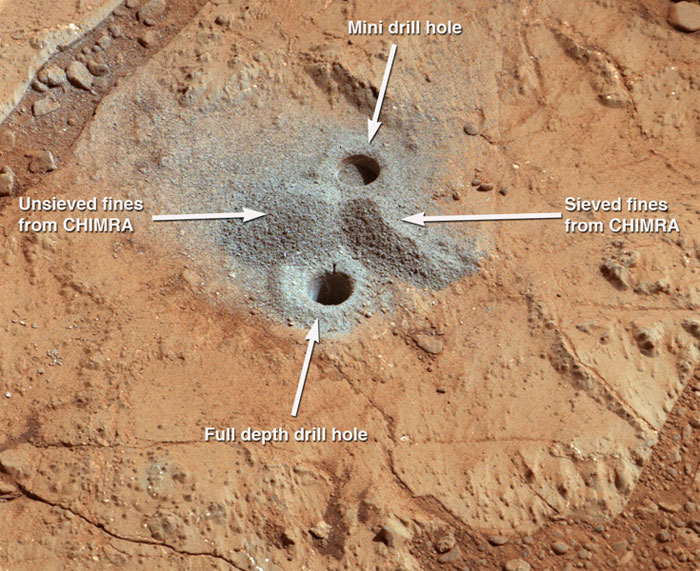
This image shows the first holes into rock drilled by NASA's Mars rover Curiosity, with drill tailings around the holes plus piles of powdered rock collected from the deeper hole and later discarded after other portions of the sample had been delivered to analytical instruments inside the rover. The image was taken by the telephoto-lens camera of the rover's Mast Camera (Mastcam) instrument in early afternoon of the 229th Martian day, or sol, of Curiosity's work on Mars (March 29, 2013). The site is on a patch of flat rock called "John Klein" in the "Yellowknife Bay" area of Mars' Gale Crater.
Each of the drill holes is about 0.6 inch (1.6 centimeters) in diameter. The one toward the top of the image was drilled on Sol 180 (Feb. 6, 2013) as a "mini drill" preparatory test. That test went to a depth of 0.8 inch (2 centimeters) without collecting any rock powder. The nearer hole is from the first rock-drilling ever to collect a sample on Mars. Curiosity drilled this hole 2.5 inches (6.4 centimeters) deep on Sol 182 (Feb. 8, 2013).
Analysis of the collected John Klein rock sample by the Chemistry and Mineralogy (CheMin) and Sample Analysis at Mars (SAM) instruments inside Curiosity produced evidence of an ancient wet environment that provided favorable conditions for microbial life, including elemental ingredients for life plus a chemical energy gradient such as some terrestrial microbes exploit as an energy source.
The sample processing and delivery tool on Curiosity, called the Collection and Handling for In-situ Martian Rock Analysis, or CHIMRA, put the collected powder through a sieve to screen out particles larger than 0.006 inch (150 microns) across, and then delivered portions of the sieved material to the instruments. After delivering a few portions for analysis over the course of several weeks, CHIMRA released both the material that had not passed through the sieve and the leftover sieved material, dropping them in two piles near the drill hole on Sol 229 (March 29, 2013). In this image from a few minutes later, the unsieved material forms a mound to the left of a line between the two holes and the leftover sieved sample material forms a mound to the right.
.
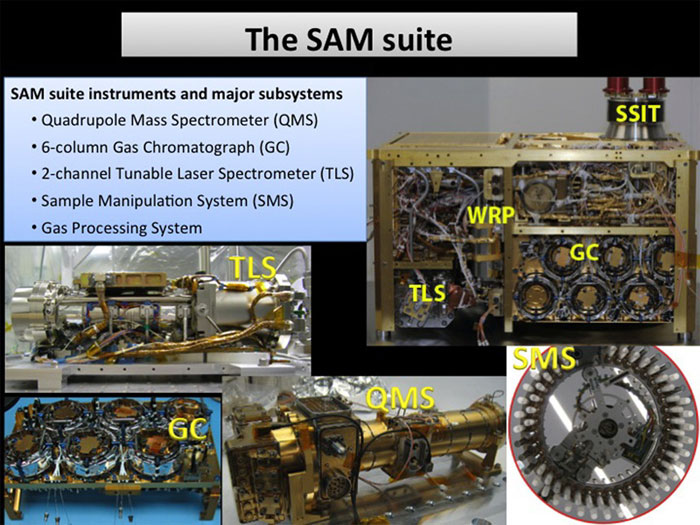
The SAM Suite
This illustration shows the instruments and subsystems of the Sample Analysis at Mars (SAM) suite on the Curiosity Rover of NASA's Mars Science Laboratory Project. The suite consists of three instruments -- quadrupole mass spectrometer (QMS), tunable laser spectrometer (TLS) and gas chromatograph (GC) -- and various subsystems including two wide range pumps (WRP), a sample manipulation system (SMS), a solid sample inlet tube (SSIT), a gas processing system and pyrolysis ovens.
SAM analyzes the gases in the Martian atmosphere and those evolved from heating the solid samples of scooped soil and drilled rock material. It provides information about the composition, abundance and isotopes of the sample.
.
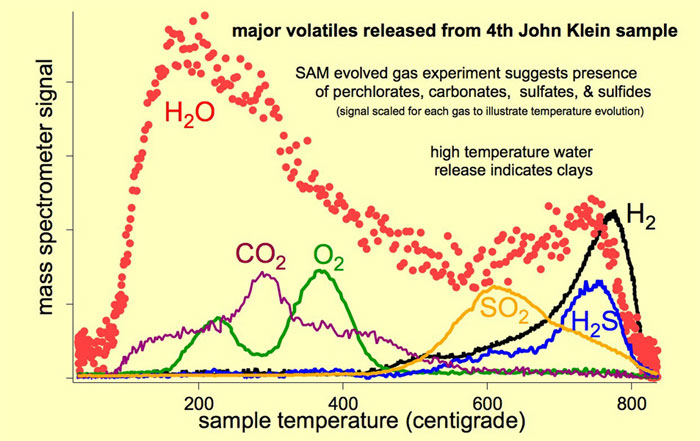
Major Volatiles Released from the Fourth 'John Klein' Portion
As the Sample Analysis at Mars (SAM) suite of instruments on NASA's Curiosity Mars rover heats a sample, gases are released (or "evolved") from the sample and can be identified using SAM's quadrupole mass spectrometer. This graphic shows the principal gases evolved from the fourth portion of powder delivered to SAM from the sample material collected when Curiosity first drilled into the "John Klein" target rock in the "Yellowknife Bay" area of Mars' Gale Crater.
The mass spectrometer signal is scaled separately for each gas so that the same graph can illustrate the patterns for various gases showing what temperatures caused the gas to be released. These evolved gases and the temperatures at which they evolved suggest the presence of hydrated minerals, carbonates, perchlorates, sulfates and sulfides, and clays in the rock-powder sample.
.
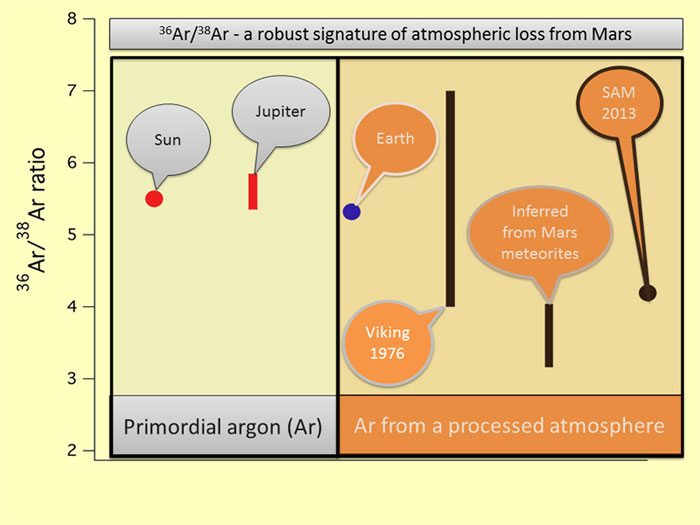
Argon Isotopes Provide Robust Signature of Atmospheric Loss
This image shows the ratio of the argon isotope argon-36 to the heavier argon isotope argon-38, in various measurements. The point farthest to the left designates a new (2013) measurement of the ratio in the atmosphere of Mars, made by the quadrupole mass spectrometer in the Sample Analysis at Mars (SAM) suite of instruments in NASA's Curiosity Mars rover. For comparison, the previous measurement at Mars by the Mars Viking project in 1976 is shown also. The SAM result is at the lower end of the range of uncertainty of the Viking data, but compares well with ratios of argon istotopes from some Mars meteorites. The value determined by SAM is significantly lower than the value in the sun, Jupiter and Earth, which implies loss of the lighter isotope compared to the heavier isotope over geologic time. The argon isotope fractionation provides clear evidence of the loss of atmosphere from Mars.
.
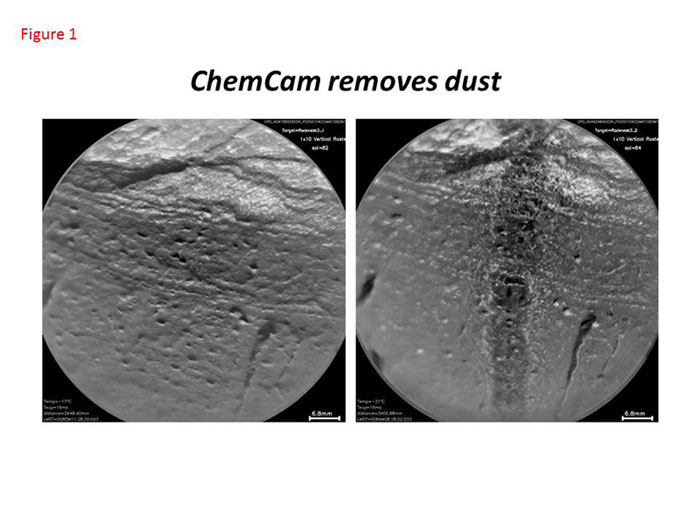
Curiosity's ChemCam Removes Dust
This pair of images taken a few minutes apart show how laser firing by NASA's Mars rover Curiosity removes dust from the surface of a rock. The images were taken by the remote micro-imager camera in the laser-firing Chemistry and Camera (ChemCam) instrument during the 84th Martian day, or sol, of Curiosity's work on Mars (Oct. 31, 2012). The area covered in each image is about 2.8 inches (7 centimeters) across, on a rock target called "Rocknest_3."
Between the time the remote micro-imager took the image on the left and the time it took the image on the right, ChemCam fired its laser 300 times -- 10 bursts of 30 shots -- along a vertical line. The image on the right shows that a stripe of dust was removed. The interaction of the laser beam with the surface is on the order of 0.02 inch (half a millimeter), but the stripe is more than 10 times wider, on the order of 0.3 inch (7 millimeters). A shock wave that occurs when the laser hits the rock is responsible for the wider area of dust removal.
Dust tends to cover everything on Mars. ChemCam has the capability to remove this layer to access the underlying rock and expose dust-free surfaces to other optical investigations.
.
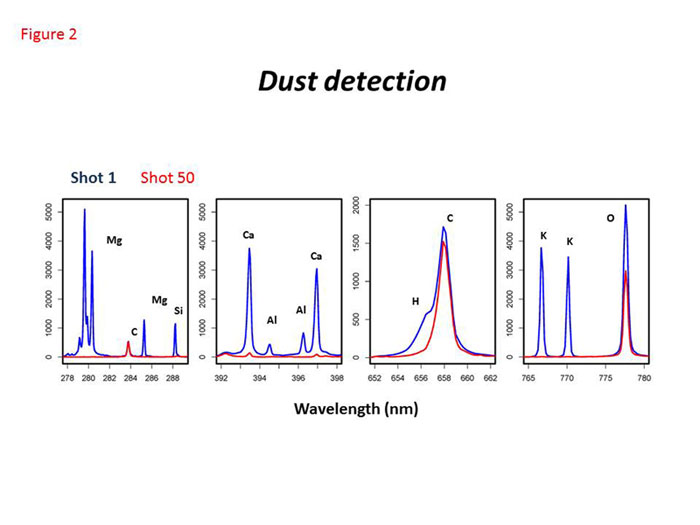
Curiosity's ChemCam Removes Dust
This pair of images taken a few minutes apart show how laser firing by NASA's Mars rover Curiosity removes dust from the surface of a rock. The images were taken by the remote micro-imager camera in the laser-firing Chemistry and Camera (ChemCam) instrument during the 84th Martian day, or sol, of Curiosity's work on Mars (Oct. 31, 2012). The area covered in each image is about 2.8 inches (7 centimeters) across, on a rock target called "Rocknest_3."
Between the time the remote micro-imager took the image on the left and the time it took the image on the right, ChemCam fired its laser 300 times -- 10 bursts of 30 shots -- along a vertical line. The image on the right shows that a stripe of dust was removed. The interaction of the laser beam with the surface is on the order of 0.02 inch (half a millimeter), but the stripe is more than 10 times wider, on the order of 0.3 inch (7 millimeters). A shock wave that occurs when the laser hits the rock is responsible for the wider area of dust removal.
Dust tends to cover everything on Mars. ChemCam has the capability to remove this layer to access the underlying rock and expose dust-free surfaces to other optical investigations.
.

Curiosity's ChemCam Analyzes Rocks, Soils and Dust
The Chemistry and Camera (ChemCam) instrument on NASA's Curiosity Mars rover analyzes Martian rocks, soils and dust at scales of less than 0.04 inch (1 millimeter). This diagram shows how materials analyzed by ChemCam during the first 100 Martian days of the mission (Aug. 5, 2012, to Nov. 16, 2013) differed with regard to hydrogen content (horizontal axis) and alkali (vertical axis).
Rocks analyzed in Gale Crater during that period show a variety of compositions, as reflected here on the alkali axis. These rocks are all characterized by a low signal for hydrogen. Soils, on the other hand, are characterized by a dynamic range in both alkali and hydrogen content. Cluster analysis of the ChemCam data set has revealed the presence of two soil components and a mechanical mixing line between them. One of the two soil components is coarse-grained soils (high alkali, low hydrogen), which are very likely made of rock fragments deposited as part of an alluvial fan from Peace Vallis on the north rim of Gale Crater. The other is finer particles with low alkali and high hydrogen, which are typically found in aeolian (wind-related) bedforms, such as the "Rocknest" deposit of windblown dusty sand where Curiosity scooped up samples for analysis by laboratory instruments. The composition of dust measured by ChemCam is similar to that of a low-alkali portion of the fine soils.
ChemCam observes spectral characteristics of dust on every first shot at any target analyzed on Mars.
.
Quelle: NASA
5898 Views
